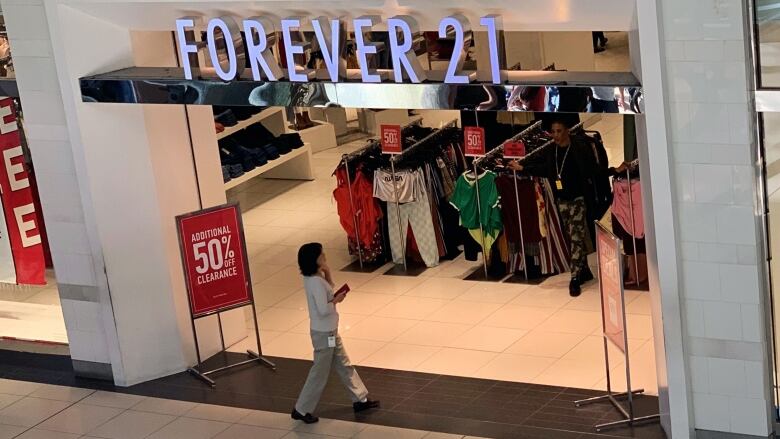Forever 21 to close all 44 locations in Canada as retailer in bankruptcy proceedings
Chain has more than 700 stores worldwide: some may survive, but none in Canada

Fashion retailer Forever 21 plans to close all 44 of its stores in Canada along with 168 of 534 stores in the U.S. as the chain undergoes bankruptcy proceedings.
The Los Angeles-based chain filed for protection from its creditors under Chapter 11 of the U.S. bankruptcy code on Monday. Asimilar filing is underway under the Canadian equivalent, the Companies' Creditors Arrangement Act.
The plan could see the chain maintain storesin the U.S., Mexico and Latin America, but an "orderly wind-down" of all Canadian locations is underway, the chain said in a release.
"Forever 21 has made the difficult decision to discontinue further financial and operational support for Forever 21 Canada as we reposition the brand and global business to adapt to the current retail environment," the chain said.
"All 44 Forever 21 Canada stores in Canada will close before the end of the year, and we have plans to liquidate our store inventory in the near term."
16% of sales online not enough
The chain, founded in 1984, at one point booked $4.1 billion in annual sales and employed 43,000 people worldwide. But those numbers have fallen this year to $3.3 billion and 35,000 as the chain has become just the latest to tumble into the pitfalls that have brought down numerous retailers of late: dwindling sales and growing debt loads at a time when online shopping is on the rise.
Bankruptcy filings suggest about 16 per cent of the chain's sales came from its digitalor online properties, but that wasn't enough to offset problems elsewhere.
Farla Efros, president of HRC Retail Advisory, saidthat's just not good enough to survive and thrive in retailing today.

"Most retailers today are ... up to 25 to 30 per cent," Efros said. Typically every sale online cannibalizes one you may have made in store, which is why e-commerce sales have to be much higher than they are at the chain to be sustainable.
"You really have to have that visibility, because every customer counts."
The chain was a pioneer of the"fast fashion" trend, where retailers such as Forever 21, H&M and others can quickly take runway looks and produce them affordably for the masses. That was a licence to print money for a while, Efros said, but the game has changed.
'Fast fashion' no longer en vogue
Retail consultant Bruce Winder said fashion is always tricky, because you are at the whim of fickle consumer tastes. If you guess poorly, you have a bunch of merchandise you can't sell, and that seems to have happened to the chain of late.
"Once you lose some of that cachet with young people, it's very difficult to get that back," he said in an interview.
Another problem in the fast fashion world is that producing basically disposable clothing that lasts barely one year is becoming less fashionable with younger consumers.
"The new sort of millennial customer and the people below them are incredibly environmentally conscious," he said.
"If young people sort of start to feel that a certain brand is disposable, that they buy, they use it a few times, and then throw it out,that's not going to resonate well with them."
While Efros says there's still money to be made in the fast fashion world, he said Forever 21 failed because their costs were too high.
That particular fate may have been sealed some time ago. The chain started expanding in a major way whenU.S. department store chain Mervyn's liquidated more than a decade ago. Forever 21 moved into some of those prime locations in the process committing tohuge square footage more akin to a department store than a nimble clothing store that sells out of the latest fashions as quicklyas it brings them in.
"It shouldn't be a department store,it should be a one-floor store," Efros said. Those stores are "super unproductive because you have to fill the space with clothing and people.
"It's really a real estate issue... the fixed costs become so astronomical that you can't make a dime."
Filings show the chain spends $450 million US a year to lease more than 12 million square feet of retail space around the world.
In its court filing, the chain admits its massiveretail footprint is likely its biggest problem.
"Many Forever 21 storefronts are located in malls," the chain said."As its neighbours have closed, the number of customers walking past Forever 21 has declined."
While the chain said it is trying to boost its online presence to make up for it, it "remains saddled with excessive floor space from leases entered almost a decade ago or more in unprofitable markets."
It also admitted it expanded too quickly. Canada was the site of the chain's first non-U.S. in location, in 2001, butmany more countries followed suit, and at its peak the chain had 251 locations in 39 countries outside the U.S.
While stores in the U.S. are still doing OK, locationsin Canada, Europeand Asia are "losing approximately $10 million per month on average over the past 12 months," the company says.
CCAA filings show the chain has assets worth $78.5 million in Canada, and liabilities of $107.6 million.
Forever 21 currently employs about 1,600 full-time and 350 part-time workers in Canada, more than half of which work in one of the chain's 22 stores inOntario and the rest at another 22 stores scattered acrossNova Scotia, Manitoba, B.C. and Alberta.
Almost all of them were given layoff notices on Monday, but the chain expects most of those jobs to remain through to the end of the year as the chain winds down operations.
With files from The Associated Press












_(720p).jpg)


 OFFICIAL HD MUSIC VIDEO.jpg)
.jpg)



























































































